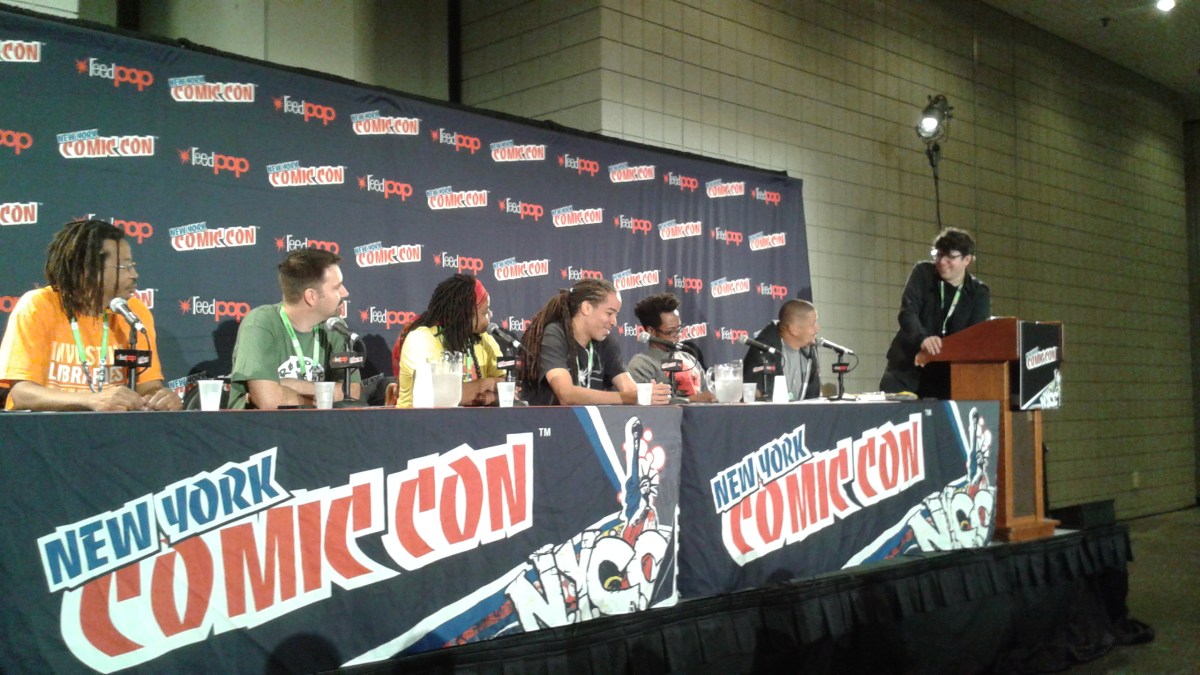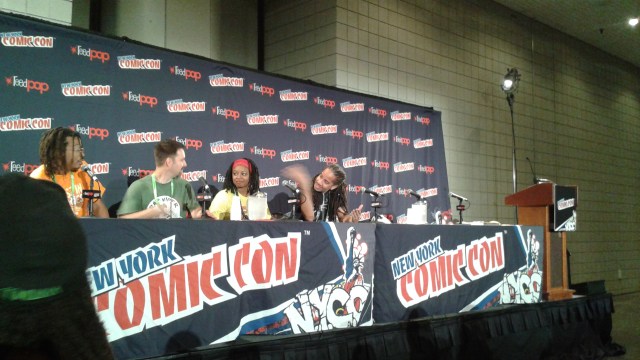[UPDATED 11:25PM] – Johnny “Juice” Rosado was actually not able to make the panel, and so professor and writer Jonathan Gray filled in. Apologies for attributing Gray’s words to Rosado. It has now been corrected throughout this post.
Hip-hop and comics have a long, intertwined history, and it was cool to see that discussed and explored at NYCC 2015. Editor of Depth of Field Magazine, Patrick Reed, moderated the panel Hip-Hop And Comics: Cultures Combining at the con, which offered the audience an insightful conversation about what hip-hop and comics have in common, what they can learn from each other, and where both should go from here.
The panel featured some heavy-hitters and legends from the hip-hop community, as well as the comics community, and the art community where all of this intersects: Chali 2na (celebrated MC from Jurassic 5; photographer and visual artist); Eric Orr (creator of Rappin’ Max Robot, the first-ever Hip-Hop comic book, graffiti and fine artist, graphic designer); Adam Wallenta (co-creator of the Public Enemy comic book, MC, songwriter, illustrator); Ronald Wimberly (designer, illustrator, writer); Likwuid Stylez (MC, songwriter, producer); and Jonathan Gray (associate professor at CUNY, writer and journalist).
First, it was cool simply to see a panel that was predominantly black (though it’s telling of both hip-hop and the comics industry that there was only one female panelist in Likquid Stylez – who, PS, was awesome). The panel started with humor – late – when most of the panel showed up five to ten minutes late (due to various travel troubles – it’s con, after all), and Gray joked that “hip-hop doesn’t wake up before noon, usually, so this is what happens when you schedule the hip-hop panel as the first panel of the day!”
Reed asked the panelists why they wanted to be on a panel combining hip-hop and comics, and most of them cited the fact that both art forms started out as DIY expressions of revolution against those that would silence marginalized groups. They saw both hip-hop and comics as rebellious. All except Wimberley, however, who provided a counterpoint throughout the entire panel. Most of the panelists grew up in the 1970s and 1980s, and so shared a specific experience growing up. For Wimberley, who’s younger, he saw both hip-hop and comics as money-making ventures.
Wimberley didn’t buy into the “geek as oppressed” narrative, saying that “There was an Incredible Hulk TV show and a Batman show. Kids were never made fun of for wearing Spider-Man pajamas,” while meanwhile, the comics companies themselves “were cakin’. They were making money.” He believes that perhaps both art forms were once about rebellion, but that in his experience, the narrative of oppression is being sold in order to also sell merch, and comics, and film tickets. And also hip-hop music. Wimberley, a working comics illustrator, thinks that nowadays – well, there’s a big difference between Public Enemy and Drake. There’s a difference between “geek culture” back in the day and geek culture today, and how today, both are being sold to the detriment of the art forms.
However, there are other (less cynical) similarities between the art forms as well. The panel discussed the use of language in both hip-hop and comics, and how the relationship between an MC and a DJ is similar to that between a comics creator and an editor.
There’s also the use of a “secret identity” in comics, and an alias in hip-hop. However Wallenta, who goes by Illus (get it? “Illest” and he’s also an illustrator?) as an MC, mentioned that these days, secret identities and aliases alike are seemingly not as popular or necessary anymore. After all, everyone knows that Tony Stark is Iron Man. Likewise, Drake is just…Drake. I guess in an age of social media where even everyday people are “brands” or “content creators,” having people connect with you personally and know your real name is important.
Orr, who created the first hip-hop comic, Rappin’ Max Robot (which is now available for viewing in the Cornell University Hip-Hop Collection!), sounded a bit discouraged as he said that, both in comics and in hip-hop, “we’re still waiting for the next cool thing.” And I have to agree. While there have been plenty of brilliant creators and hip-hop artists, there has yet to be that huge, innovative artists that takes the art forms to the next level.
Gray cited 1987 as an example of a time when we saw a huge shift in both hip-hop and comics; it was the year of Public Enemy, Watchmen, and Frank Miller’s The Dark Knight Returns. There was a lot going on politically that inspired works that changed what we expected from those art forms. He sounded more hopeful about the future, however. Gray is excited about 2016, which will bring with it a “Black Lives Matter” Night Thrasher at Marvel, written by David Walker. He also cited the Black Panther movie as something to watch for, particularly since it now has a black male screenwriter (Joe Robert Cole), director (F. Gary Gray), and of course, star (Chadwick Boseman) involved.
One of the more interesting comments of the panel, however, came from Likwuid when discussing how it feels to be a woman who both loves and works in hip-hop and who loves comics. She finds it interesting that “women are more likely to buy, while guys are more likely to make the trip to the comics shop to hang out and read in the store.” So, when thinking about who is actually giving the comics industry money, it makes financial sense to create books that are female-inclusive. Indeed.
Oh, and by the way, there was only one mention of the Marvel Hip-Hop covers by Wimberley. He was citing them as an example of the commodification of hip-hop, but there wasn’t then a nuanced conversation about it – everyone just moved on. Shame, as I was hoping to get all their takes on that. As you know, I happen to love them, especially because there are artists of color involved in creating them, and they have the support of the hip-hop artists themselves.
On the whole, the panel was a lot of fun, and the conversation was amazing. They tend to do a Hip-Hop and Comics panel every year at NYCC, so if you missed this one, keep your eyes peeled for a similar panel at next year’s NYCC. Hip-hop and comics – two great tastes that taste great together!
What do you think? Is there a “next cool thing” in either hip-hop or comics? Who are the innovators right now? Where do you think we’re headed? Let’s talk about it in the comments below!
(Photos taken by Yours Truly on her phone – so any lack of photographic quality is totally my fault.)
—Please make note of The Mary Sue’s general comment policy.—
Do you follow The Mary Sue on Twitter, Facebook, Tumblr, Pinterest, & Google +?











Published: Oct 13, 2015 05:51 pm